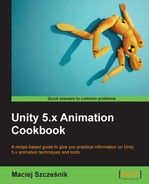The Animation View is divided into three main parts, as shown in the following screenshot:

- Playback buttons (1): Here you can play back the animation on your scene (you do not have to enter Play Mode to see your animation). On the right to the play back buttons, you can find an Insert Key Frame button and an Insert Animation Event button. You can use the first one to insert key frames; the second one inserts Animation Events that allow to call script functions from an animation (Animation Events will be covered later in Chapter 6, Handling Combat). Just below the playback buttons, you can find a drop-down menu, with which you can switch between this object's animations and add new ones.
- Animated properties (2): Here you can find all the properties of the game object used by this animation. You can also click on the Add Property button to add new properties to the animation.
- Timeline (3): It represents the time in the animation. You can find all the key frames (and animation events) here. You can click on the timeline header (the one with time displayed in seconds) to go to the frame you clicked on. If you click on a key frame instead, the timeline will automatically jump to that exact key frame.
When you create an animation in the Animation View for the first time for a given game object, a new Animation Clip and an Animation Controller are created. The Animator Controller is automatically assigned to the game object you are animating and the Animation Clip is added to the Animator Controller. Any new animation created for the same game object will be added to the same Animator Controller automatically.
